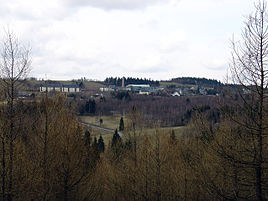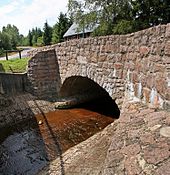Schellerhau
|
Schellerhau
City of Altenberg
Coordinates: 50 ° 46 ′ 16 ″ N , 13 ° 41 ′ 40 ″ E
|
||
|---|---|---|
| Height : | 761 m above sea level NHN | |
| Residents : | 383 (December 31, 2018) | |
| Incorporation : | January 1, 1996 | |
| Postal code : | 01773 | |
| Area code : | 035052 | |
|
Location of Schellerhau in Saxony |
||
|
View of Schellerhau
|
||
Schellerhau is a district of the Saxon city of Altenberg . It belongs to the district of Saxon Switzerland-Eastern Ore Mountains . At the end of 2014, around 420 people lived in Schellerhau.
geography
The once independent municipality is located in the eastern Ore Mountains about 8 km north of the state border with the Czech Republic and about 45 km south of the state capital Dresden . Schellerhau extends for a length of about 4.5 km in a north-south direction along the county road 9045. Neighboring towns are Altenberg in the south, Rehefeld in the west, Bärenfels in the north and Wald- and Oberbärenburg in the east.
The place is morphologically assigned to the northern roof of the Ore Mountains and has the character of a low mountain range. The altitude is between 650 and 804 m above sea level. NHN . The highest point in the region is the Kahleberg at 905 m above sea level. NHN . The place is surrounded by extensive coniferous forests in which the common spruce is predominant. Birch , beech , mountain ash and maple appear in a subordinate position . The settlement was created by clearing both sides of today's village street. The open spaces gained in this way were used as arable land and pasture land. The field stones were piled up along the parcel boundaries perpendicular to the road and form ecologically valuable stone ridges. The resulting settlement structure is called Waldhufendorf.
The receiving water is formed by the Rote Weißeritz .
history
Tell about the origin
One day the devil had another argument with his grandmother. He left hell in a rage. He had packed a number of houses in his sack. He wanted to start his own business somewhere on earth. However, he hadn't noticed that a piece of glowing coal from hellfire had gotten into the sack. As he was flying over the Schellerhauer heights, the coal burned a hole in the sack and the devil lost one house after another. The houses fell at a great distance from each other. When the devil noticed that he had lost almost all of the houses, he threw the rest down and shouted: “To the flayer!” Since then, the flayer has had to live in the last house in Schellerhau .
Indeed
At the end of the 3rd millennium BC Year after year in the summer months, elites resident in the Elbe Valley dug through tin barley on the Rote Weißeritz near Schellerhau . The workers lived in simple booths during the season. The tin obtained with a technique similar to panning for gold was brought to the permanent settlements in the Elbe Valley, which prospered and gained wealth and reputation. At that time the Ore Mountains developed into a central supplier for all of Europe. Tin was essential in bronze manufacture . The traces of mining discovered in Schellerhau by the Archeo Montan research project are currently the oldest in Europe.
The first proven settlement dates back to 1534. In the further search for minable ore, Magnus von Bernstein auf Bärnstein prompted Hans Schelle to found a settlement on the Silberstrasse from Altenberg to Freiberg in order to initially supply the Altenberg mines with wood and coal. The place of inheritance court was assigned to Hans Schelle, who became the first judge. He was followed by Martin Baumgart, named in 1609, in his office as judge. Gradually an independent Waldhufendorf developed with large parcels of land for the miners to self-suffice with food, so that in 1561 an own parish office with a wooden church could be inaugurated by the first pastor "Magister Antonius Lauterbach" according to a letter from the Duke of Saxony. As early as 1590, the construction of the Schellerhauer grinding mill began on behalf of Caspar von Bernstein. After the Schellerhau tin ore mining came to a standstill in the Thirty Years' War , the barren Landhufen had to feed the families, which were often very large. Since this was not enough, a considerable part of the men operated wage-wagon, forest work or some other handicraft on the side. Nevertheless, Schellerhau remained a very poor village until the 20th century.
During the GDR era, children recovered in a holiday camp that was operated in the village in the 1950s. In 1983, the complex of the FDGB recovery home was added, which was built at the foot of Stephanshöhe (804 m above sea level) and was named after the politician Otto Buchwitz . After reunification it became a hotel and has been owned by the Ahorn hotel chain since 2002 as the Ahorn Waldhotel Altenberg. Next to the hotel was the "Casino", a restaurant built in GDR times.
Attractions
- Botanical garden , laid out in 1906 on an area of around 1.5 hectares , visitors are mainly presented with plants from the Ore Mountains and the alpine low and high mountains of Europe, North America, Asia and the Caucasus. The employees take care of the conservation breeding of endangered native plants and thus participate in the species protection program of the Free State of Saxony.
- Village church , built 1561–1593 and expanded with a stone tower in the 18th century
- Schinderbrücke: Stone bridge from 1789/90 over the Rote Weißeritz
- The gallery and museum in the Heimatstuben (former restaurant, cultural center and local administration) with an exhibition of works by regional artists and artisans were opened in a festive setting on May 26, 2018. The house was originally called Niederer Gasthof and from 1913 to 1951 by Karl May's alleged daughter Helene Voigt . operated. In the gallery there are quarterly changing exhibitions and monthly events such as concerts, readings and lectures.
Events
- Schellerhauer Kammlauf (cross-country skiing event, annually in February)
- Garden festival of the Botanical Garden with nature market (every summer)
- Schellerhauer Advent procession followed by cutting of the stollen and Christmas market on the First Advent
- Monthly events (concerts, lectures, readings) in the gallery and museum Heimatstuben (see notices)
Partner communities
- Auggen in the Markgräflerland
- Frille , part of Petershagen in the Minden-Lübbecke district in East Westphalia ; Partner community of the Schellerhau volunteer fire brigade
traffic
It was planned to set up a stop on the Pöbeltalbahn in Schellerhau . However, this railway line was never realized. There are bus connections with neighboring towns.
Personalities
- Alfred Lottermoser (1870–1945), chemist known for his work on colloid chemistry
literature
- Michael Barthel, Siegrid Siegismund: Schellerhau Botanical Garden. Publishing Association for the Promotion of Nature in the Eastern Ore Mountains, Bärenstein 2005
- Around Altenberg, Geising and Lauenstein (= values of the German homeland . Volume 7). 1st edition. Akademie Verlag, Berlin 1964.
- Community administration Schellerhau (ed.): From the local history of Schellerhau. 450 years of Schellerhau, 400 years of the church. Schellerhau 1993
- Martin Hammermüller: Osterzgebirge - Kipsdorf, Bärenfels, Bärenburg, Schellerhau, Rehefeld. Series of our little traveling booklet Vol. 11, Leipzig 1961
- Richard Steche : Schellerhau. In: Descriptive representation of the older architectural and art monuments of the Kingdom of Saxony. 2. Issue: Amtshauptmannschaft Dippoldiswalde . CC Meinhold, Dresden 1883, p. 74.
- Dietrich Papsch, Sonnensucher am Kahleberg, Verlag Neue Literatur, 2005, ISBN 3-938157-18-6 .
- Dietrich Papsch, Schellerhauer Impressionen, Vogt Printing House, Coswig, 2008
- Dietrich Papsch, Schellerhau - Discoveries over 400 years of art in a lovable place, printer and publisher Hille Dresden, 2018
Web links
- Site of the place
- Schellerhau on altenberg.de
- Schellerhau in the Digital Historical Directory of Saxony
Individual evidence
- ↑ Numbers and facts on the website of the city of Altenberg
- ↑ a b From the local history of Schellerhaus , published by the municipal administration and the Schellerhau parish; Leipzig 1993
- ↑ Saxony's history began much earlier than expected. In: Sächsische Zeitung from November 1, 2018.
- ↑ Master Christoph Meißnern: Cumbersome news of the Churfl. Saxon. Schrifftsäßigen free tin mining town Altenberg . Dresden and Leipzig 1747.
- ↑ State Archives Dresden (ed.): Purchase book Schellerhau . 1608, p. 280 .
- ^ Dresden State Archives (ed.): Conf. of the pastor's office established in 1561 in the village of Schellerhau . LOC 9908/17. Schellerhau / Dresden 1561.
- ↑ Dresden State Archives (ed.): Comparison between Caspar von Bernstein himself and his subjects in Schellerhau because of the construction services of the mill in Schellerhau in 1590 . Altenberg Office 209. Schellerhau / Bärenstein / Dresden 1590.
- ^ Website with a personal report on the children's recreation home in Schellerhau
- ↑ Mandy Schaks: Tee at the Stephanshöhe. In: saechsische.de. December 8, 2015, accessed April 13, 2020 .
- ↑ Dresden State Archives (Ed.): Conf . Concerning the parish lair established in 1561 in the village of Schellerhau . LOC 9908/17.
- ↑ August Schumann, Albert Schriffner: Complete state post and newspaper lexicon of Saxony ..., Volume 10 . 1825, p. 266-268 .
- ^ Christian Heermann : love stories . In DNN of October 13, 2008, p. 16.
- ↑ Schellerhauer Kammlauf






